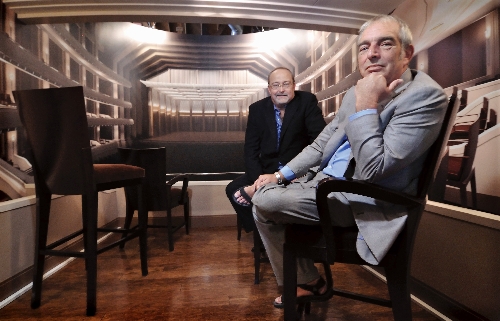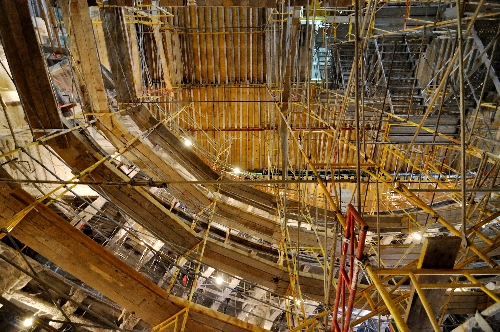Smith Center for Performing Arts on the rise in downtown Las Vegas
Like a seasoned orchestra, an arrangement of elite engineers, architects and consultants is working symphonically in downtown Las Vegas to create the Smith Center for the Performing Arts.
The $470 million multivenue music and performance complex at Grand Central Parkway and Bonneville Avenue promises to be an elegant, functional art deco-inspired composition, project officials said. The 200,000-square-foot Smith Center, which broke ground earlier this year, is scheduled to open in late 2012.
"Our goal is to create a spectacular, grand sequence of spaces that build excitement from the moment a visitor arrives to the moment they take their seat," Smith Center President and CEO Myron Martin said. "We're trying to create an unforgettable space that feels exactly correct for what is happening on stage."
Smith Center consists of two buildings on 4.75 acres, including the 2,050-seat Reynolds Hall with 23 box balconies and a 100-person orchestra pit. There is also a 300-seat cabaret theater overlooking a 2-acre park and a 200-seat studio theater for rehearsals and community events.
But the Smith Center's most impressive features may also be the least visible -- rich sound, great views and an intimate visitor experience.
Project leaders have assembled a team of 25 designers and specialists for a high-tech facility that uses science and engineering to subtly enhance performance. David M. Schwarz, whose résumé includes the Nancy Lee & Perry R. Bass Performance Hall in Fort Worth, Texas, is the design architect. HKS Inc. is executive architect. Fisher Dachs Associates is theater consultant. Akustiks is the acoustical designer.
"The secret to building a successful performance hall is having audience members not notice the technology," Schwarz said. "People should always believe that it's an absolutely magical, effortless experience, and what they see on stage is the whole story. Of course, that is never the case."
Smith Center neighbors the Union Pacific Railroad tracks and rumbling railcars could rattle the building and ruin a show. Smith Center, however, has a superthick concrete-mat foundation with hundreds of underground pylons that reduce vibration.
Reynolds Hall is constructed independently, as a building within a building, with its own frame and foundation. Walter P. Moore is the project's structural engineer.
"The foundation under Reynolds Hall is three feet thick because of the proximity of the railroad tracks, as opposed to a normal 6- to 8-inch slab," Walter P. Moore principal Abhijit Shah said. "It additionally has 2-foot thick concrete walls that deaden ambient noise."
Buildings normally have columns to help support itself and counteract gravity. They hold the building upright but may obstruct views. Reynolds Hall, though, is column-free. The 110-foot-tall structure displaces the building load through a supersized roof and reinforced exterior walls, which are costlier to construct but make for more memorable performances, project officials said.
The auditorium roof is supported by three 10-foot deep steel trusses as long as a basketball court. The largest truss weighs 36 tons or slightly more than a Sherman tank.
The roof consists of a 1-foot-thick concrete slab that quiets noise from overhead airplanes and helicopters while supporting a catwalk and stage lighting. Smith Center uses 4,000 tons of structural steel, which is enough to build 1,556 full-size cargo containers.
The steel is also used in other ways. Reynolds Hall has four tiers of seats that cantilever toward the 56-foot-by-120-foot stage, thereby shortening the distance between audience members and performers. Each horseshoe-shaped level is angled for optimal viewing. The space is flexible, accommodating string quartets and symphonies, Broadway musicals and solo recitals, and never loses its acoustic muscle.
"We worked to define how the auditorium surfaces would be articulated and shaped to diffuse and scatter sound evenly throughout the room," Akustiks principal Paul Scarbrough said. "We used a combination of computer and scale models to test the key acoustical attributes of the space."
Smith Center can delicately alter its theater environment through "sound and light locks," whereby a double set of entrance and exit auditorium doors can be opened or closed to refract or amplify sound. This feature also keeps hallway light, which can disrupt performers and audience members, from spilling into the auditorium.
Theaters without double doors expose themselves to a potential ruckus when someone leaves for the bathroom in the middle of a show or an audience member arrives late and a door slams shut. But, Reynolds Hall isn't physically attached to the building's outer shell for a buffer space.
Smith Center selected strong, durable items that required little maintenance, including 2,458 tons of Indiana limestone that will blanket the building exterior. The complexion of limestone changes over time for a weathered, velvety texture that suggests permanence and tradition, project officials said. Limestone also doesn't require new paint, upkeep or frequent replacement.
Interior finishes can change the resonance of a musical instrument or a singer's aria. So, hard and soft materials were selected and scrutinized for optimum theater acoustics. Smith Center built a replica-scale model outfitted with microphones for testing surfaces, flooring and ceilings, to determine the right combination of finishes and materials for the best overall sound.
The comprehensive planning mindset extends to ventilation and air conditioning. Smith Center designers attached heating and cooling ducts overhead to the outer shell frame to limit mechanical racket. Large ducts are also used to better control airflow; fast-flowing air can create clatter.
Like a good showman, Smith Center is designed to never let the audience see its inner workings or backstage chaos.
"A lot of this is very psychological, understanding how light and the acoustics couple to create an experience," Schwarz said. "You never want anybody to focus on anything but what is on stage. If the audience notices anything else then the design team has done something wrong."
Contact reporter Tony Illia at tonyillia@aol.com
or 702-303-5699.




















